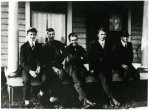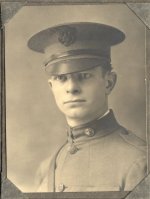
Pauling's Years as an Undergraduate at Oregon Agricultural College, Part 1 (1917-1919)
1917
On October 6, Pauling enters Oregon Agricultural College in Corvallis, then a city of about six thousand people (the college has nearly 3,500 students).
On October 8, Pauling registers for 19 ½ credits as a chemical engineering major: general chemistry, mechanical drawing, mining and explosives, calculus, analytic geometry, modern English prose, military science drill, and physical education. With the exception of his calculus course, Pauling finds his first semester courses a disappointment. During this time, he rooms with his cousin Mervyn Stephenson.
After his summer savings are used up, he goes to the Student Employment Bureau. He gets work doing odd jobs in a girls’ dormitory (the pay is $25 per hundred hours of work each month).
Because of his heavy work load in and out of class, he does not have time to attend his gym classes (which, to be honest, he finds "boring"). As a result, he gets his only F in college.
1918
After going home for his Christmas vacation, Pauling returns on January 7 to the OAC campus for the Winter Short Course. His financial problems become severe during this time. He is also asked to leave the boardinghouse because he makes too much noise tramping up the stairs in his heavy military boots.
During the winter and spring, he goes through several changes of address, sometimes rooming with friends, other times taking whatever he can find.
In the spring semester, Pauling’s courses are mostly continuations from his fall and winter courses. He hears about the Throop College of Technology from two students who have recently flunked out of this small school in Pasadena, California.
In May, Pauling is runner-up in the contest for the best soldier in OAC’s Military Inspection Day.
In June, Pauling and Mervyn Stephenson travel to the Presidio in San Francisco where they spend one month in military training.
In June, Belle Pauling marries William Brace Bryden, a lumberman, but the marriage proves to be a disaster and it is quickly dissolved.
During the summer months, Pauling works in a shipyard in Tillamook, a small town on the ocean about 55 miles west of Portland. He carries lumber, heats rivets, and performs other tasks involved in the construction of a 4,000-ton wooden ship.
In the fall, Lloyd Jeffress enters OAC as a freshman electrical engineering major. During the first semester, Pauling and Jeffress room together in a private home which belongs to the campus electrician.
Pauling’s sophomore courses include engineering physics, metallurgy, and analytical chemistry. To obtain money for his various expenses, he works in the stockroom where he prepares standard solutions and unknowns for students in various chemistry courses.
The money from this job, along with what he has saved from his work at the Tillamook shipyard, helps him to make ends meet.
Pauling meets Paul Emmett, a friend of Lloyd Jeffress. Emmett will become Pauling’s lifelong friend.
1919
In the spring, Pauling joins the Gamma Tau Beta fraternity. He passes the initiation rites with flying colors. However, in the course of fraternity life, he submits to a dunking in a tubful of water rather than date girls.
In May, Carl Pauling, his grandfather, dies of lobar pneumonia, and Linus returns home for the funeral.
In June, Pauling’s cousin Mervyn Stephenson graduates from OAC. He then goes to southern Oregon to work as a civil engineer.
At the start of the summer, Pauling works for the Riverside Dairy, delivering milk to about 600 customers in Portland between 8PM and 4AM each night, seven nights a week. He finds this eight hour shift very difficult, and when the opportunity arises for him to get a job with the State of Oregon, he quickly accepts.
For the rest of the summer, he works near Wolf Creek, a small town in southern Oregon, about 60 miles west of Crater Lake. From this town, he travels to a camp alongside a creek in the mountains, where he lives in a tent and inspects the blacktop pavement that is being laid. His main job is to monitor the quality of the bitumen-stone mixes.
During his leisure time, he speculates about the relationship between the structures of substances and their magnetic properties (he obtains his data from a standard chemical reference work).
Toward the end of the summer, he receives a letter from his mother, informing him that she has been forced to use all the money he has been sending her. Lacking the financial resources to cover his junior-year expenses, Pauling remains at his job and does not return to OAC.
Through the early autumn months, Pauling continues to work as a paving-plant inspector in southern Oregon.
Table of Contents
- The Ancestry of Linus Pauling (The Paulings)
- The Ancestry of Linus Pauling (The Darlings)
- Linus Pauling's Childhood (1901-1910)
- Linus Pauling's Adolescence (1910-1917)
- Pauling's Years as an Undergraduate at Oregon Agricultural College, Part 1 (1917-1919)
- Pauling's Years as an Undergraduate at Oregon Agricultural College, Part 2 (1919-1922)
- Linus Pauling as a Graduate and Postdoctoral Student at the California Institute of Technology, Part 1 (1922-1923)
- Linus Pauling as a Graduate and Postdoctoral Student at the California Institute of Technology, Part 2 (1924-1926)
- A Guggenheim Fellow in Europe during the Golden Years of Physics (1926-1927)
- Early Career at the California Institute of Technology (1927-1930)
- Pauling's Great Years of Achievement in Structural Chemistry, Part 1 (1931-1932)
- Pauling's Great Years of Achievement in Structural Chemistry, Part 2 (1933-1935)
- Pauling's Increasing Involvement in Molecular Biology (1936-1939)
- The War Years, Part 1 (1940-1942)
- The War Years, Part 2 (1943-1945)
- The Postwar Years, Part 1 (1946-1947)
- The Postwar Years, Part 2 (1948-1949)
- Proteins, Passports, and the Prize (1950-1954)
- Increasing Involvement in World Peace, Part 1 (1955-1958)
- Increasing Involvement in World Peace, Part 2 (1959-1963)
- The Center for the Study of Democratic Institutions (1964-1967)
- The University of California, San Diego (1968-1969)
- Stanford University (1969-1972)
- An Institute for Science and Orthomolecular Medicine, Part 1 (1973-1977)
- An Institute for Science and Orthomolecular Medicine, Part 2 (1978-1981)
- The Years Alone: Pauling after the Death of Ava Helen, Part 1 (1982-1988)
- The Years Alone: Pauling after the Death of Ava Helen, Part 2 (1989-1994)
- About the Author




